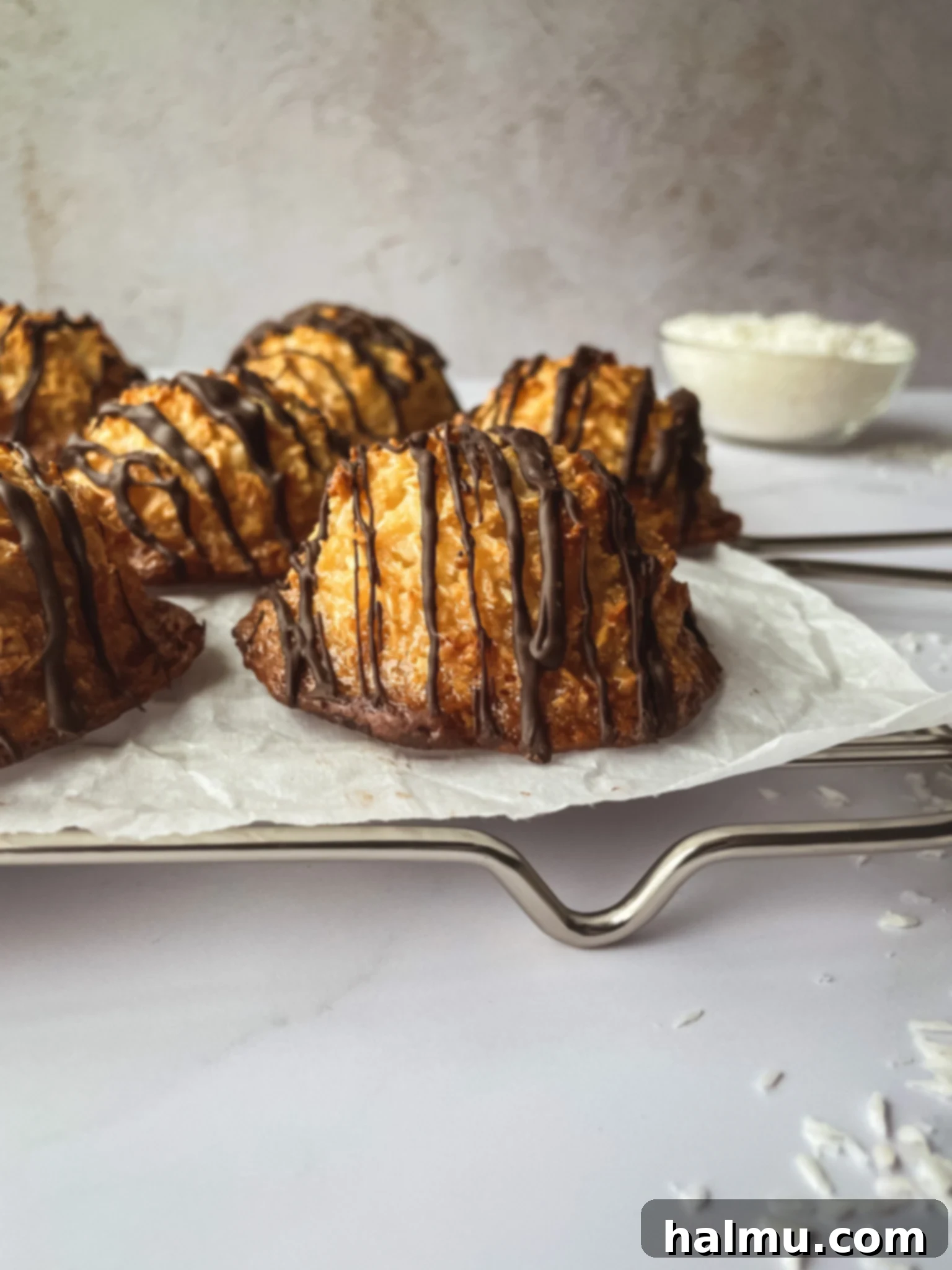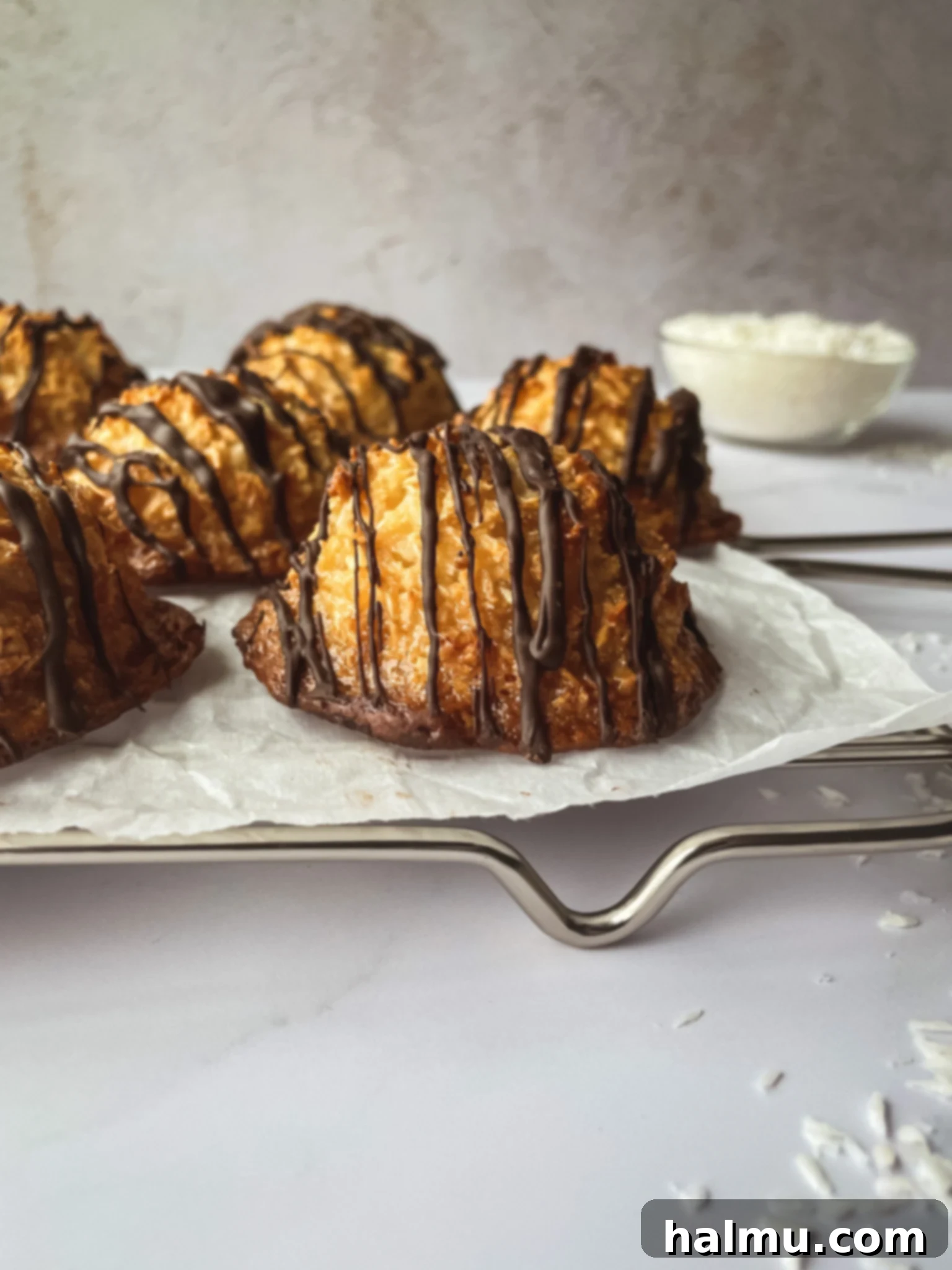
Welcome to the ultimate guide for crafting the most delightful **Chewy Coconut Macaroons**! Imagine a perfect bite: a golden, slightly crisp exterior giving way to an incredibly soft, moist, and wonderfully chewy interior bursting with tropical coconut flavor. These aren’t just any macaroons; they’re a testament to simplicity and irresistible taste, promising to become a cherished addition to your baking repertoire. You’ll be amazed at how effortlessly these treats come together, requiring just four fundamental ingredients. Naturally gluten-free, they are an excellent choice for sharing with friends, family, or bringing to any gathering, ensuring everyone can enjoy their sticky-sweet goodness.
Whether savored plain, allowing the pure coconut essence to shine, or elegantly drizzled with rich melted chocolate for an added layer of indulgence, these homemade macaroons are guaranteed to satisfy. Each bite is a journey to a sweet paradise, and we can confidently say you’ll find yourself reaching for another long before the plate is empty. Get ready to bake a batch of these simple, yet profoundly satisfying, coconut confections that are sure to earn rave reviews!

Crafting the Perfect Chewy Coconut Macaroons: A Step-by-Step Guide
Making delicious coconut macaroons from scratch is a surprisingly simple process, even for novice bakers. The key lies in understanding a few basic techniques that guarantee that coveted chewy texture and golden-brown finish. Follow these detailed steps to achieve macaroon perfection every time.
- Prepare the Base Mixture: Begin by combining the fresh egg whites, granulated sugar, and honey in a sturdy saucepan. Place the saucepan over low heat on your stovetop. It’s crucial to warm this mixture gently and consistently. Stir frequently with a whisk or rubber spatula to prevent the egg whites from cooking too quickly or curdling. Your goal is to dissolve the sugar completely and allow the mixture to reach a temperature of approximately 140°F (60°C). Using a reliable digital thermometer is highly recommended to monitor the temperature accurately. This warming process is vital; it helps to dissolve the sugar crystals, ensuring a smooth, non-gritty macaroon, and slightly thickens the egg whites for better structure without actually cooking them. Make sure to remove the mixture from the heat promptly once it hits 140°F to avoid overcooking the eggs, which could lead to a scrambled texture rather than a smooth base.
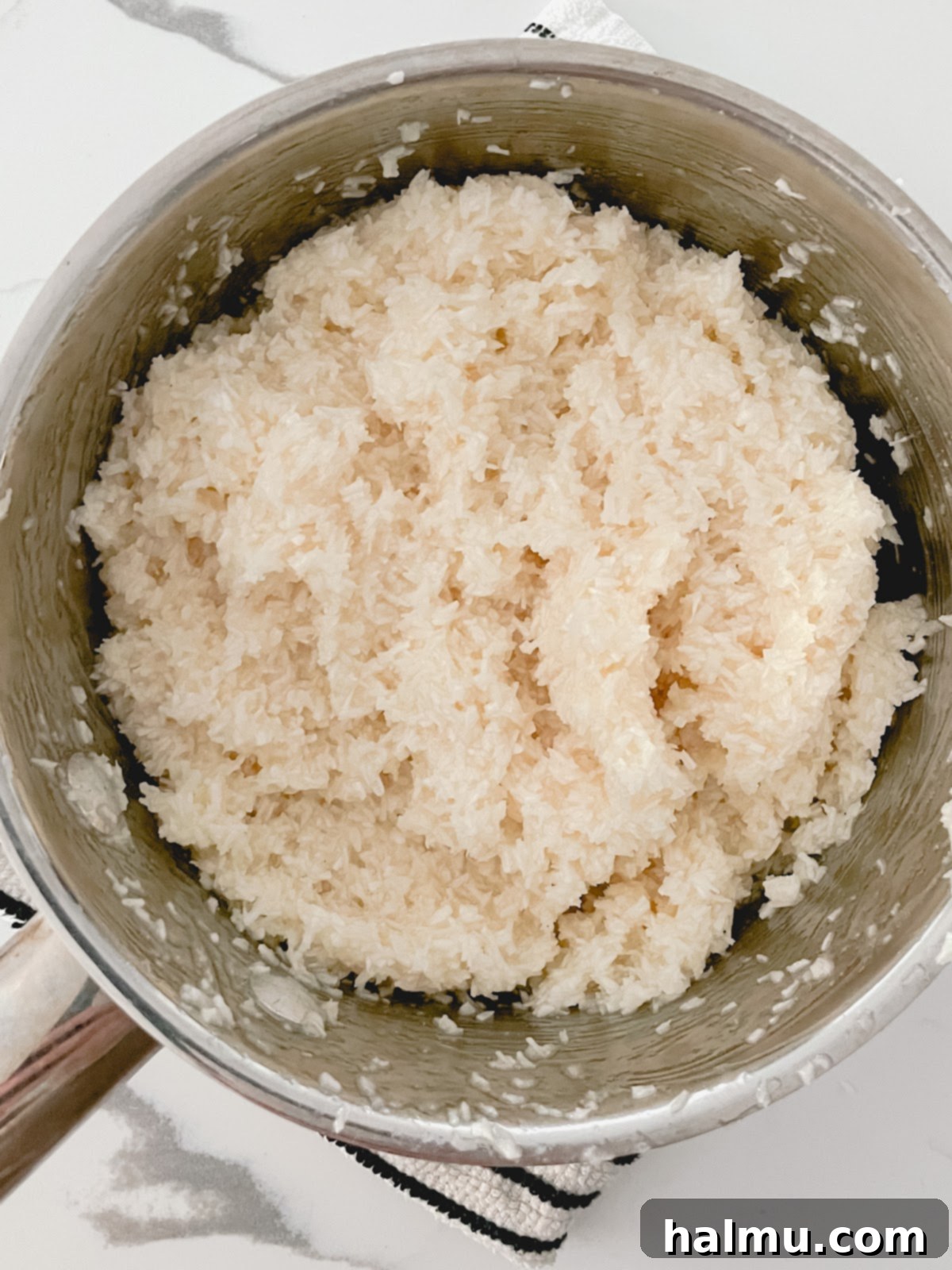
- Incorporate Coconut and Rest: Once your egg white mixture has reached the desired temperature, immediately remove it from the heat source. Now, it’s time to introduce the star ingredient: the coconut! Add the finely shredded unsweetened coconut to the warm mixture and stir thoroughly until every strand of coconut is well coated and integrated. This step ensures an even distribution of flavor and moisture. After mixing, allow the coconut mixture to rest at room temperature for about 20-30 minutes. This resting period is critical for the success of your macaroons. During this time, the coconut will absorb much of the excess liquid from the egg white mixture, causing it to firm up slightly. This absorption helps prevent the macaroons from spreading too flat in the oven, ensuring they maintain their delightful mounded shape and achieve that perfectly chewy texture. Don’t skip this step for the best results!
- Portion, Bake, and Golden Perfection: After the resting period, give the coconut mixture one final stir to ensure everything is perfectly combined and homogenous. Preheat your oven to 325°F (160°C). Prepare two baking sheets by lining them with parchment paper or, for even easier removal, a silicone baking mat. Using a large cookie scoop (a 2-tablespoon capacity scoop works wonderfully), portion out the macaroon mixture onto the prepared baking sheets. Leave about 1.5 to 2 inches of space between each macaroon to allow for slight expansion during baking. Bake the macaroons for approximately 20-22 minutes. Keep a close eye on them during the final minutes; you’re looking for a beautiful deep golden brown color all over. This indicates that the sugars have caramelized, creating those coveted crisp edges and a deeply flavorful interior. The vibrant golden hue is a sign of perfectly baked, incredibly delicious macaroons.
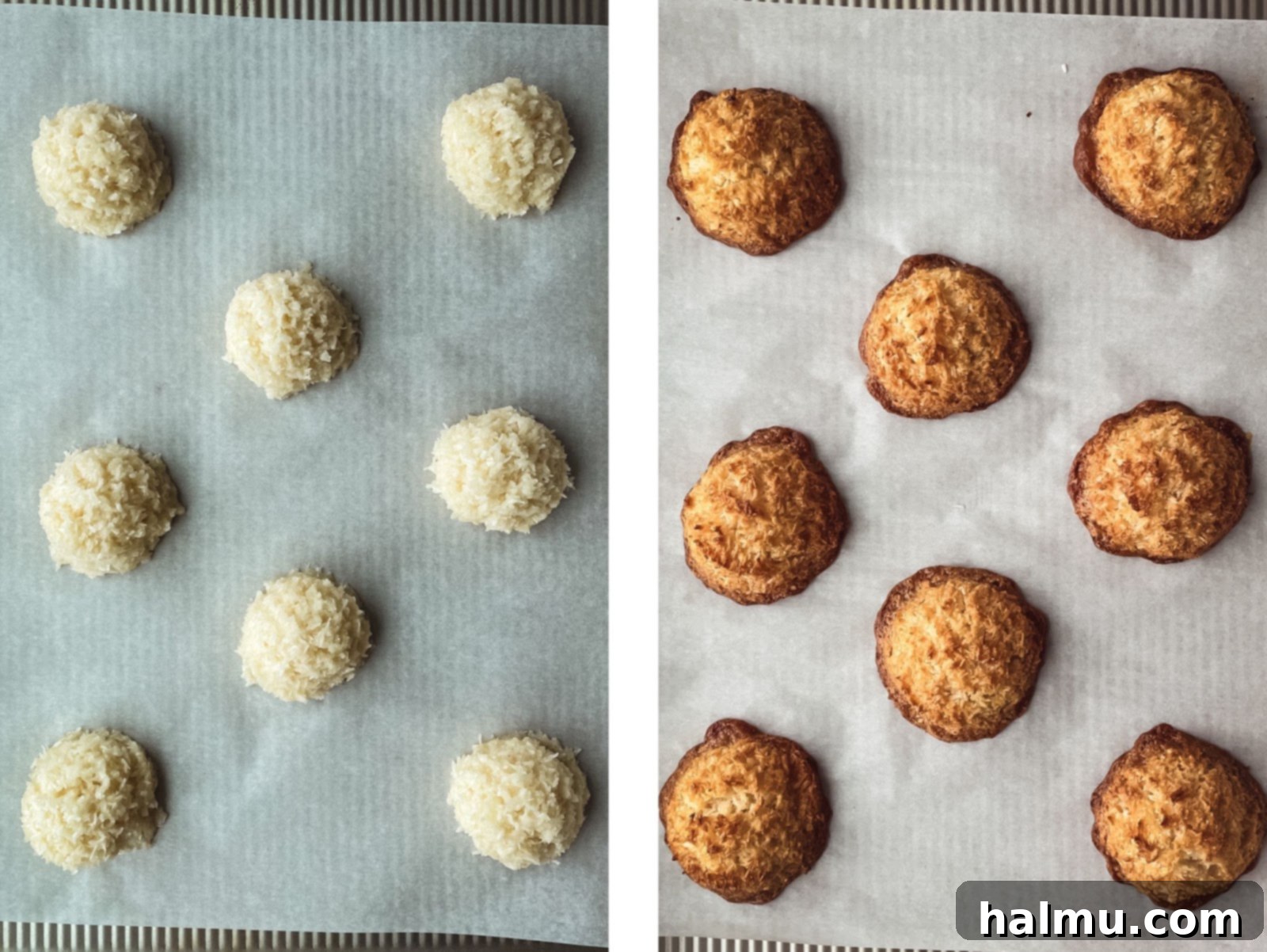
- Cool, Drizzle, and Serve: Once baked to golden perfection, remove the macaroons from the oven. It’s essential to allow them to cool completely on the baking sheet. Resist the urge to move them too soon, as they are delicate when warm and need time to set up and become firm. Once fully cooled, carefully peel them away from the parchment paper or silicone mat. This is where a silicone mat truly shines, as its non-stick surface makes removal incredibly easy. For an extra touch of decadence, drizzle the cooled macaroons with melted chocolate. You can use dark, milk, or white chocolate, depending on your preference. A spoon or a piping bag with a fine tip works well for an elegant finish. After drizzling, pop the sheet pan of macaroons into the fridge for about 5-10 minutes, just until the chocolate sets up firm. This quick chill helps the chocolate harden beautifully. Once set, your delightful chewy coconut macaroons are ready to be served and enjoyed! Prepare for compliments and requests for the recipe!

Insider Tips for Baking the Best Coconut Macaroons
Achieving truly exceptional coconut macaroons goes beyond just following the steps; it involves understanding the nuances that elevate a good macaroon to a great one. Here are some essential tips to ensure your macaroons are always perfectly chewy, golden, and utterly delicious.
- Opt for Unsweetened Coconut: This recipe is meticulously developed to balance sweetness using unsweetened shredded coconut. If you opt for sweetened coconut, which often contains added sugars and sometimes preservatives, your macaroons will be considerably sweeter – potentially overwhelmingly so – and the moisture content may differ. Unsweetened coconut allows you to control the sugar level precisely and delivers a more authentic, pronounced coconut flavor. Always check the label!
- Embrace the Resting Period: The 20-30 minute rest at room temperature after mixing in the coconut is not a suggestion; it’s a critical step for success. During this time, the coconut flakes absorb the liquid from the egg white and sugar mixture. This absorption process makes the mixture firmer and less prone to spreading excessively during baking. A well-rested mixture yields macaroons that hold their shape beautifully, resulting in that classic mounded appearance and desirable chewy texture, rather than flat, crispy disks.
- Patience is Key: Cool Completely: We know it’s incredibly tempting to dive into a warm, fragrant macaroon straight from the oven, but resist the urge! Coconut macaroons need to cool completely on the baking sheet. As they cool, their structure sets, the edges become perfectly caramelized and gooey, and the interior transforms into that wonderfully chewy consistency we all crave. Warm macaroons can be fragile and sticky, making them difficult to handle and prone to falling apart.
- Invest in a Silicone Baking Mat: While parchment paper certainly works well for baking macaroons, their sticky nature can sometimes make them a challenge to peel off cleanly and in one piece. A high-quality silicone baking mat offers superior non-stick properties, making the removal of these ooey-gooey delights effortless. If you have one, now is the time to use it! If not, just exercise a little extra care and patience when peeling them from parchment paper.
- Don’t Overbake: While a deep golden brown is desired, going too far can result in dry, overly crisp macaroons that lose their signature chewiness. Keep a close watch on them during the last few minutes of baking. The edges should be richly golden, and the centers should still appear moist and slightly soft before they are pulled from the oven.
- Ensure Consistent Portioning: Using a cookie scoop is not just for convenience; it’s vital for achieving uniformly sized macaroons. Consistent size ensures that all your macaroons bake evenly and are ready at the same time. This also contributes to a professional and appealing presentation.
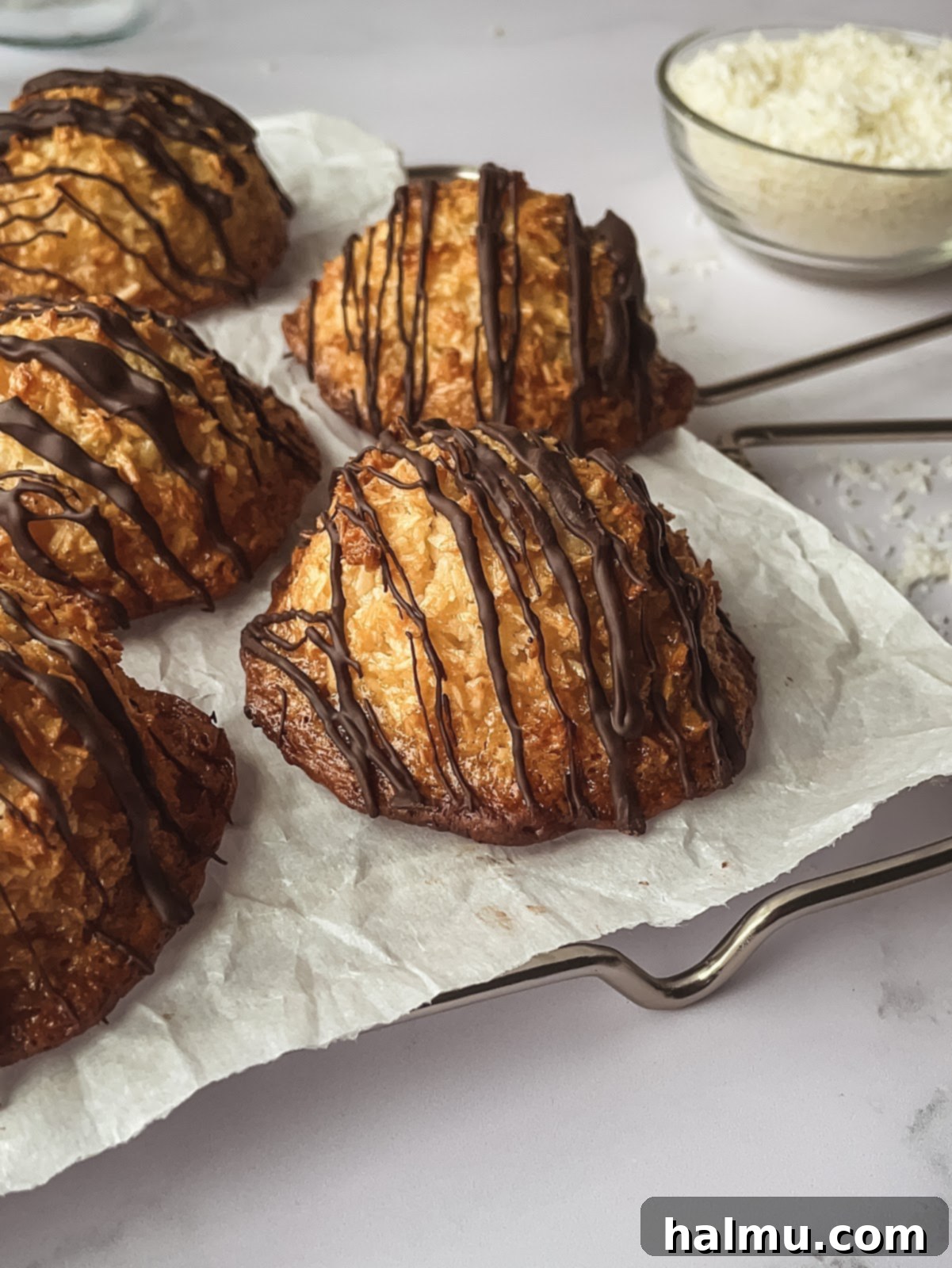
Frequently Asked Questions About Coconut Macaroons
Here are answers to some of the most common questions about baking, storing, and enjoying these delightful coconut treats.
What is the best way to store coconut macaroons?
To maintain their optimal freshness and chewiness, store your macaroons at room temperature. Arrange them in a single layer within a zip-top plastic bag or an airtight container. If you need to stack them, place a piece of parchment paper between layers to prevent them from sticking together. They will remain wonderfully fresh and delicious for up to 3 days. For longer storage, consider refrigerating them, which can extend their shelf life by a few extra days, although the texture might become slightly firmer.
Do these freeze well?
Absolutely, these coconut macaroons freeze beautifully, making them perfect for meal prepping desserts or saving some for a later craving! To freeze them effectively, first arrange the completely cooled macaroons on a baking sheet lined with parchment paper. Place the baking sheet in the freezer for at least 2 hours, or preferably overnight, until the macaroons are completely frozen solid. This prevents them from sticking together. Once frozen, transfer the individual macaroons into a heavy-duty zip-top freezer bag or an airtight freezer-safe container. They can be stored in the freezer for up to 3 months. To enjoy, simply thaw them at room temperature for an hour or two, or briefly warm them in the microwave for a few seconds for a soft, fresh-baked feel.
Can I use thicker shredded coconut?
For this specific recipe, I highly recommend using finely shredded coconut. The smaller, finer shreds allow for better absorption of the liquid ingredients, which is crucial for achieving the desired chewy texture and ensures the macaroons hold their shape beautifully during baking. While it might be tempting to use a thick flake or coconut chip, I would not recommend it as it may not absorb the liquid as effectively, potentially leading to a drier, more crumbly macaroon or one that spreads too much. The fine shred creates a more cohesive and tender end product.
Can I use toasted coconut?
It’s best to use plain, unsweetened shredded coconut for this recipe. These macaroons develop a wonderfully deep golden brown color and significant caramelization during the baking process. If you were to start with already toasted coconut, you run a high risk of over-toasting them in the oven, which could result in a burnt flavor and an undesirably dry, overly crisp texture. For the perfect balance of flavor and texture, let the oven do all the toasting for you!
What is the difference between a macaroon and a macaron?
This is a very common question! While their names sound similar, coconut macaroons and French macarons are distinctly different confections. Coconut macaroons, like the ones in this recipe, are rustic, chewy mounds made primarily from shredded coconut, egg whites, and sugar. They are simple to prepare and naturally gluten-free. French macarons, on the other hand, are delicate, elegant sandwich cookies made from almond flour, egg whites, and granulated sugar, filled with ganache, buttercream, or jam. They have a smooth, crisp shell and a soft, chewy interior, requiring much more precise technique to master.
Why are my macaroons flat or spreading too much?
Several factors can lead to flat macaroons. The most common reasons include not allowing the coconut mixture to rest adequately (the resting period is crucial for coconut to absorb moisture and for the mixture to firm up), using sweetened coconut (which can alter the moisture balance), or your oven temperature being too low (leading to excessive spreading before the macaroons can set). Ensure your egg whites are not over-whipped, as this can also contribute to a looser batter. Following the resting instruction and using unsweetened, finely shredded coconut will significantly help prevent spreading.
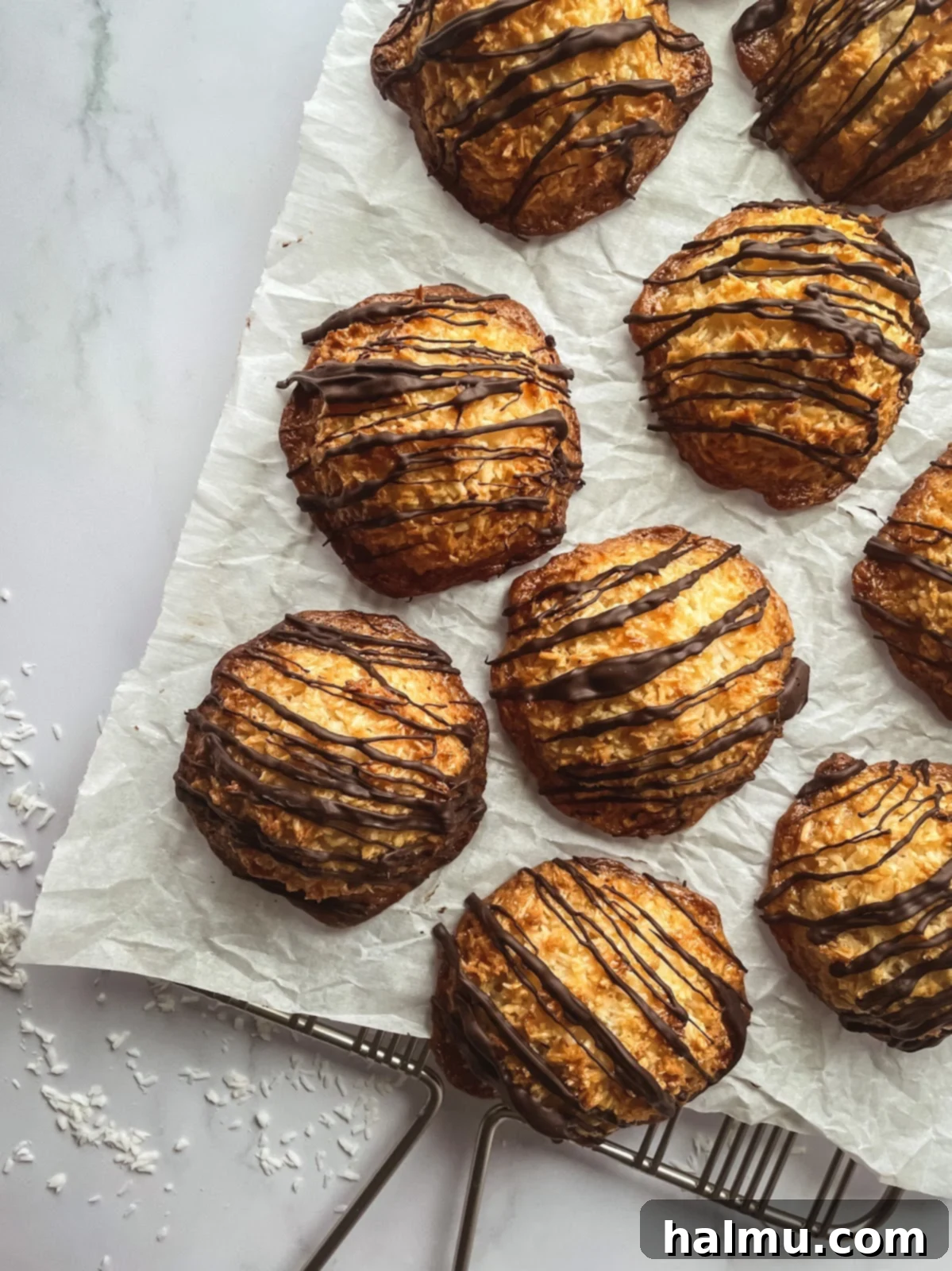
More Delicious Recipes You’ll Love from Sweet Kitchen Cravings
If you enjoyed making these Chewy Coconut Macaroons, you’re in for a treat with more delightful recipes from our kitchen. Explore a variety of baked goods, from tangy cookies to rich cheesecakes, all designed to bring joy to your baking experience:
- Bright and Zesty Lemon Curd Cookies
- Irresistible Mini Biscoff Cheesecakes
- Decadent Chocolate Chip Banana Cake with Creamy Chocolate Frosting
- Fluffy Almond Cream Brioche Buns
- Comforting Blueberry Streusel Coffee Cake Loaf
Finally, we absolutely love seeing your culinary creations! If you make this fantastic Chewy Coconut Macaroon recipe, please don’t forget to leave a comment below sharing your experience. We also invite you to tag @sweetkitchencravings on Instagram or TikTok. If Pinterest is more your style, feel free to save our recipes to your collections there for future baking inspiration. Happy baking!
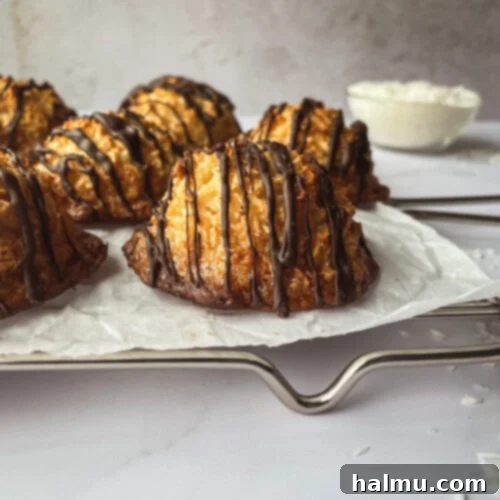
Chewy Coconut Macaroons
Print Recipe
RATE THIS RECIPE
Ingredients
- 4 large egg whites, preferably at room temperature
- ¾ cup (150g) granulated sugar
- ¼ cup (90g) honey, liquid and good quality
- 2 ¼ cups (185g) finely shredded, unsweetened coconut
- Melted chocolate, for drizzling (optional, dark or milk chocolate recommended)
SHOP INGREDIENTS
Instructions
- In a small, heat-proof saucepan, combine the four large egg whites, ¾ cup (150g) granulated sugar, and ¼ cup (90g) honey. Place the saucepan over very low heat on your stovetop. Continuously whisk or stir the mixture gently but frequently until it becomes warm to the touch and all the sugar crystals are completely dissolved. Use a digital thermometer to ensure the mixture reaches approximately 140°F (60°C). This gentle warming process ensures a smooth, non-gritty macaroon base. Crucially, do not allow the temperature to exceed 140°F to prevent the egg whites from curdling. Remove from heat immediately once the target temperature is reached.
- Once removed from heat, stir in the 2 ¼ cups (185g) of finely shredded, unsweetened coconut into the warm egg white mixture. Mix thoroughly until the coconut is fully coated and evenly incorporated. Set the bowl aside at room temperature and allow the mixture to rest for a crucial 20-30 minutes. This resting period is essential; it gives the coconut time to absorb the liquid, causing the mixture to firm up slightly. This step is key to preventing your macaroons from spreading too flat in the oven and helps achieve their signature chewy texture.
- While the macaroon mixture is resting, preheat your oven to 325°F (160°C). Line two baking sheets with parchment paper or, for superior non-stick performance and easier cleanup, use a silicone baking mat.
- After the resting period, give the macaroon mixture another quick stir to ensure consistency. Using a large cookie scoop (about 2 tablespoons), portion out the mixture onto the prepared baking sheets, leaving approximately 1.5 to 2 inches of space between each macaroon. This spacing allows for even airflow and prevents them from sticking together. Bake for 20-22 minutes, or until the macaroons are a beautiful deep golden brown all over, indicating perfect caramelization and doneness.
- Remove the baked macaroons from the oven and allow them to cool completely on the baking sheets. This cooling time is vital for them to set up and develop their characteristic chewy texture and firm structure. Once fully cooled, if desired, melt your chosen chocolate and drizzle it decoratively over the macaroons using a spoon or a piping bag. For the chocolate to set, place the pan of drizzled macaroons into the fridge for about 5-10 minutes. Once the chocolate is firm, your homemade chewy coconut macaroons are ready to be served and thoroughly enjoyed!
Notes
- Storing: Store freshly baked coconut macaroons in a single layer in a zip-top plastic bag or an airtight container at room temperature for up to 3 days. For slightly longer storage, they can be refrigerated for up to 5 days, though their texture may firm up a bit.
- Freezing: These macaroons freeze exceptionally well! Freeze them first on a parchment-lined baking sheet until solid (2+ hours), then transfer to a freezer-safe bag or container for up to 3 months. Thaw at room temperature before serving.
- Variations: Feel free to customize! You can add a teaspoon of vanilla extract or almond extract to the egg white mixture for a different flavor profile. For a citrusy twist, fold in a teaspoon of lemon or orange zest with the coconut. You can also mix in finely chopped nuts like pecans or walnuts for added crunch.
- Chocolate Coating: Instead of a drizzle, you can fully dip the cooled macaroons in melted chocolate for a more indulgent treat. Allow excess chocolate to drip off, then place on parchment paper to set in the fridge.
